Cisco’s Automation Solution for Routed Optical Networking White Paper
Available Languages
Bias-Free Language
The documentation set for this product strives to use bias-free language. For the purposes of this documentation set, bias-free is defined as language that does not imply discrimination based on age, disability, gender, racial identity, ethnic identity, sexual orientation, socioeconomic status, and intersectionality. Exceptions may be present in the documentation due to language that is hardcoded in the user interfaces of the product software, language used based on RFP documentation, or language that is used by a referenced third-party product. Learn more about how Cisco is using Inclusive Language.
Transform network operations with a modular application ecosystem, best-in-class infrastructure software, and multivendor support. Network automation substantially increases network efficiency to lower the cost per bit and maximize profit.
Disruptive network transformation may only happen once a decade. First movers can set agendas and force competitors to defend for years. Cisco's Routed Optical Networking solution fundamentally changes how IP and Optical networks are built and operated forever. In this whitepaper, you will learn how Cisco’s Converged SDN Transport architecture and Crosswork Automation helps reduce inefficient use of network capital and simplifies operations for the 5G era. Specifically, Cisco's Routed Optical Networking Solution transforms customers’ financials with up to 35% CapEx and 57% OpEx savings.
Service providers are preparing for the next big rise in data consumption driven by cloud, IoT, and 5G with a multifold surge in bandwidth demand.
The role of the service provider network has never been more critical. Service providers will need to redesign their network architecture to respond to customer demands for robust networks with high speeds and bandwidth and reliable connectivity.
Converged and automated transport networks is a solution here to simplifying network operations and optimizing management workloads, giving service providers the ability to rapidly launch new revenue-generating services, reduce network TCO, and meet high customer expectations.
Routed Optical Networking, part of the Converged SDN Transport architecture, is a new network paradigm that delivers improved operational efficiencies and simplicity. The solution works by merging IP and private line services onto a single layer where all the switching is done at Layer 3. Routers are connected hop by hop with standardized pluggable coherent optics. With a single service layer based upon IP, flexible management tools can leverage telemetry and model-driven programmability to streamline lifecycle operations. This simplified architecture integrates open data models and standard APIs, enabling a provider to focus on automation initiatives for a simpler topology.
Cisco’s network automation solution for Routed Optical Networking
Cisco’s automation solution for Routed Optical Networking focuses on simplifying the operations of converged IP and optical networks as shown in Figure 1. The solution also allows service providers to leverage the same stack for management of existing brownfield networks that have siloed IP and optical domains enabling a seamless transition.
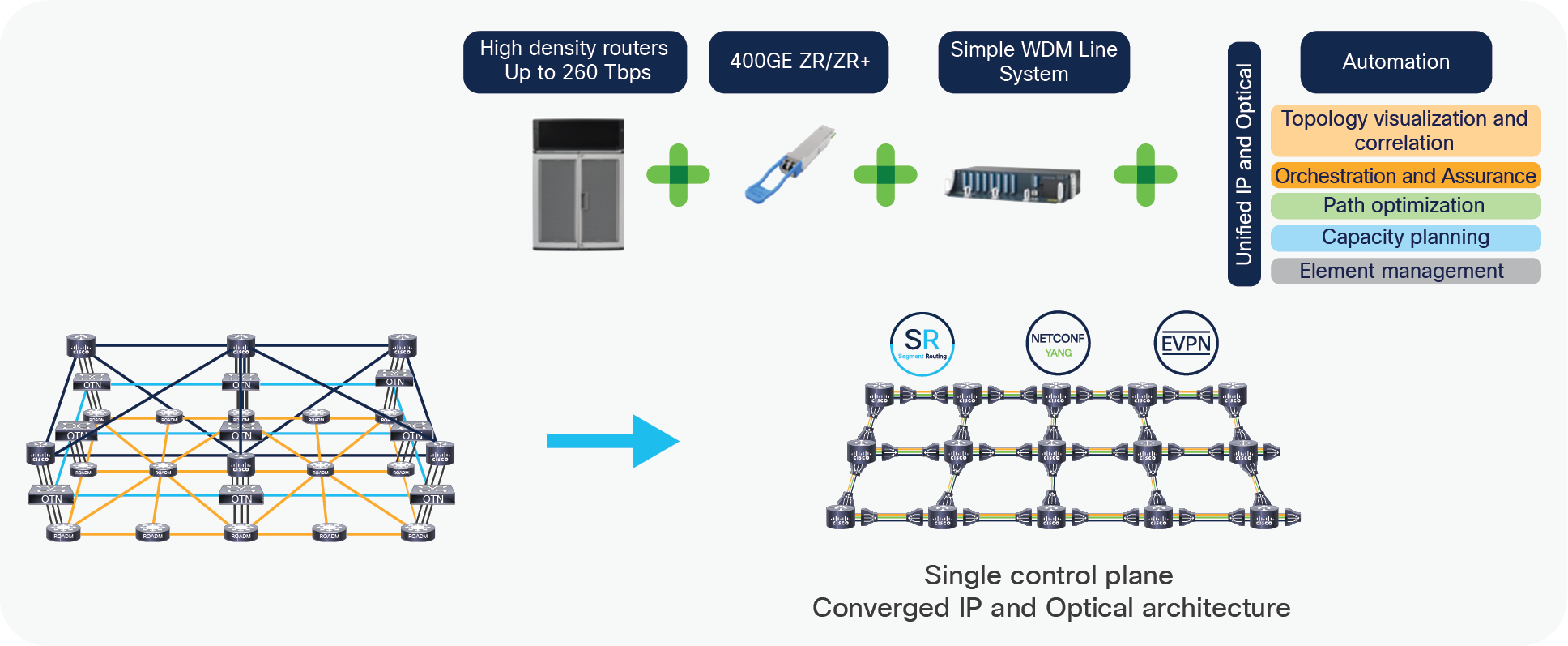
Cisco’s Routed Optical Networking architecture simplification
Cisco’s Routed Optical Networking automation solution focuses on delivering the key functions in Figure 2 to reduce the OpEx of managing IP and optical networks, enable faster time to market by automating service rollouts, and optimize the CapEx spend.
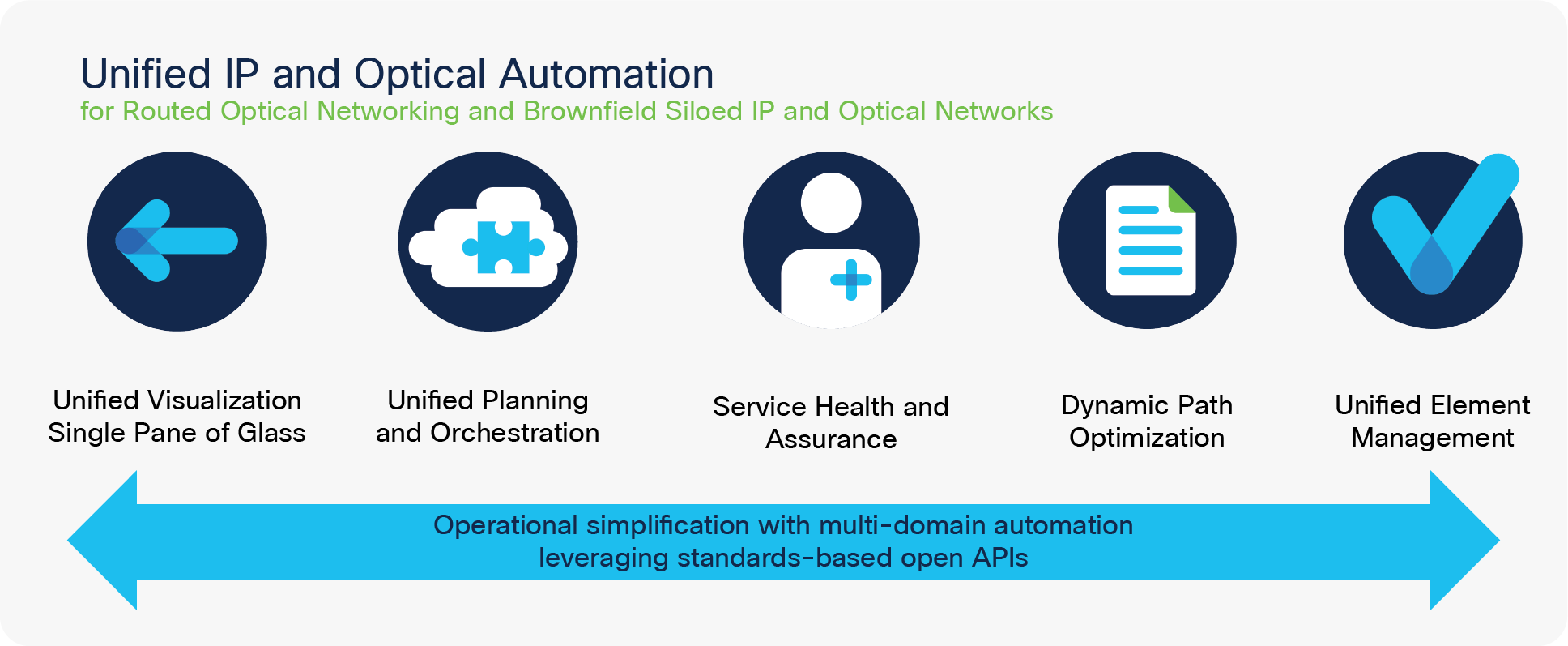
Cisco’s Routed Optical Networking automation key functions
Cisco’s automation solution for converging the IP and optical layers closely follows the standards-based architecture described in this paper. It consists mainly of the following Cisco Crosswork® automation components shown in Figure 3.
● A hierarchical controller – Cisco Crosswork Hierarchical Controller, powered by Sedona’s NetFusion
● A multivendor IP controller – Cisco Crosswork Network Controller (CNC)
● An optical controller – Cisco® Optical Network Controller (CONC)
● An element management system for IP and optical – Evolved Programmable Network Manager (EPNM)
● A planning tool for IP and optical – Unified Planning powered by WAN Automation Engine (WAE)
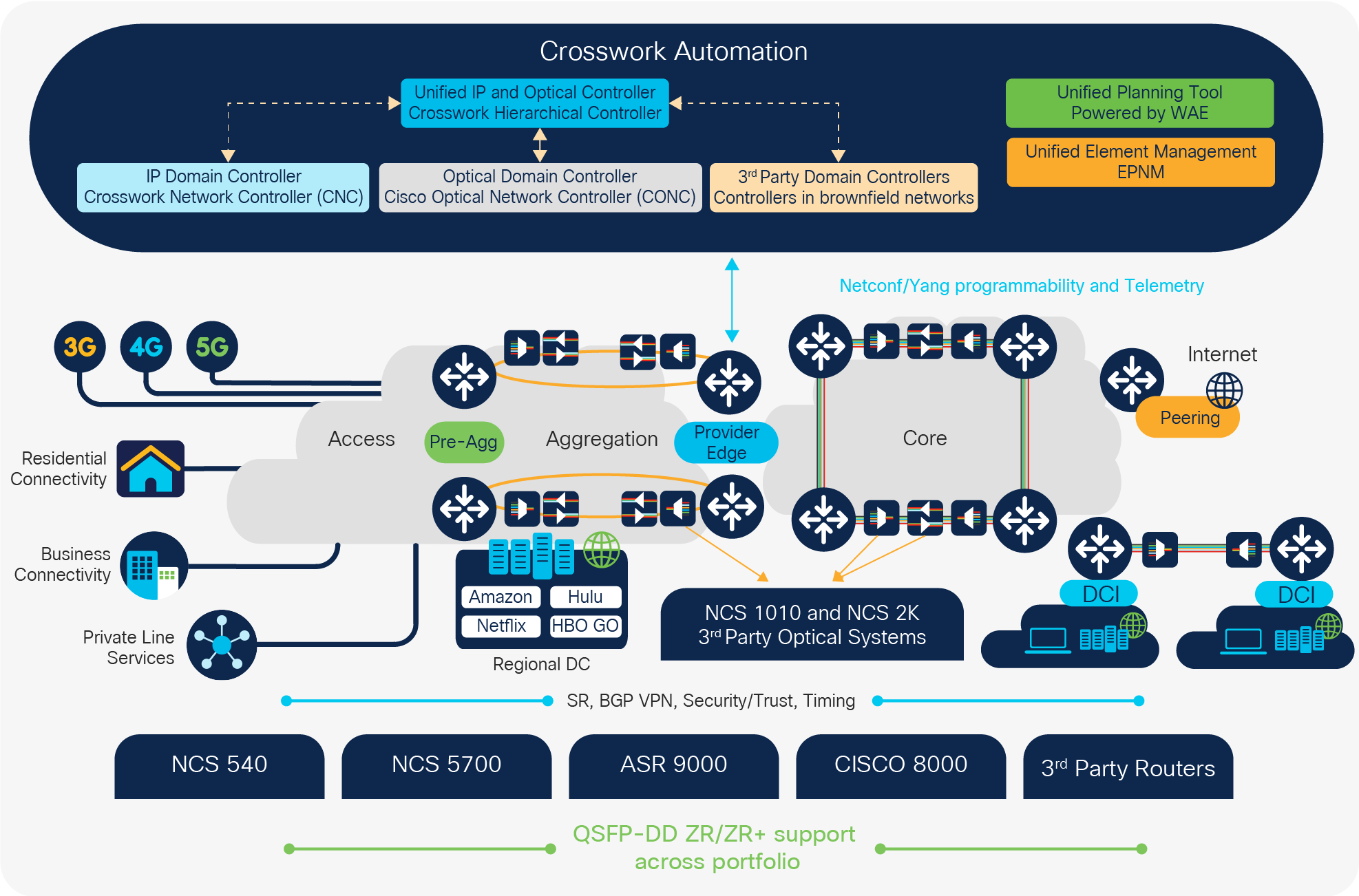
Cisco’s Routed Optical Networking portfolio
The Cisco automation solution caters for existing siloed multidomain, multilayer, multivendor networks and has new innovative features to enable customers to go through the three main phases of transforming their network to a converged IP and optical architecture as illustrated in Figure 4 below.
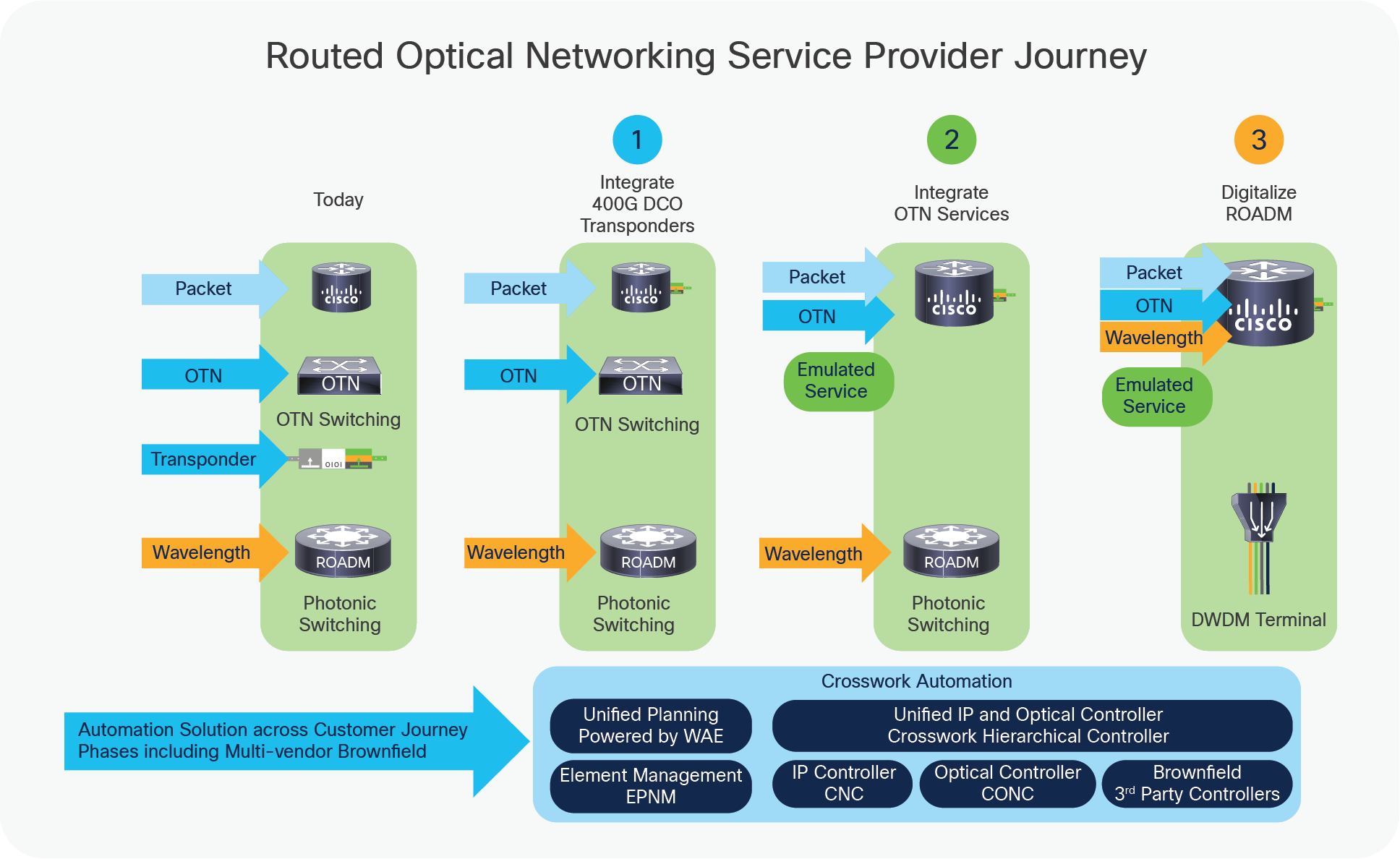
Service provider journey through Routed Optical Networking deployment phases
Routed Optical Networking evolutionary journey with Cisco
The service provider evolutionary journey to adopting Routed Optical Networking leveraging Cisco’s Converged SDN Transport architecture can be characterized by three key phases described below.
Phase 1: Integrate 400G DCO transponders
In this first phase of Routed Optical Networking, service providers realize significant savings by moving from dedicated transponder shelves to cost-optimized digital coherent optics based on industry-standards of ZR and ZR+ that can plug into routers and run as alien wavelength over existing optical line systems. The Cisco automation solution allows service providers to have a single pane of glass with topology correlation from the service layer down to IP and optical network layers for the new deployment and the existing brownfield networks. The automation solution provides complete lifecycle management, including planning, service orchestration and assurance, path optimization, and element management.
Phase 2: Integrate OTN services
The second phase of Routed Optical Networking allows service providers to converge all their services onto a single IP SDN transport network and hence eliminate the dedicated OTN layer that carries only private line services. This is possible via Private Line Emulation (PLE), which enables private line services to be carried over the same IP network. This enables maintaining the same service-level agreements and service characteristics such as guaranteed bandwidth and persistent bidirectional paths leveraging innovations in Segment Routing Circuit–style EVPN extensions and circuit emulation for bit transparency. PLE is fully automated via Crosswork Automation, which provides bandwidth reservation, bidirectional path optimization, service assurance and orchestration for private line services, and service visibility from the service layer down to the fiber.
The third phase of Routed Optical Networking provides a fully converged IP and optical architecture over a simplified DWDM network with a single control plane. The IP/MPLS network carries all services, allowing OTN switching to be phased out. Service provider CapEx is optimized with the simpler network architecture, and OpEx is reduced due to leaner operations. The Crosswork automation solution manages this simplified network along with the other existing brownfield multilayer siloed networks from a single pane of glass along with offering seamless automated migration capabilities.
Crosswork automation solution components
Crosswork Automation’s controller architecture aligns to industry standards that define an IP domain controller, optical domain controller, and hierarchical controller. The Crosswork controllers interact via standard interfaces based on IETF for the IP layer and Telephony Application Programming Interface (TAPI) for the optical layer, as shown in the figure below.
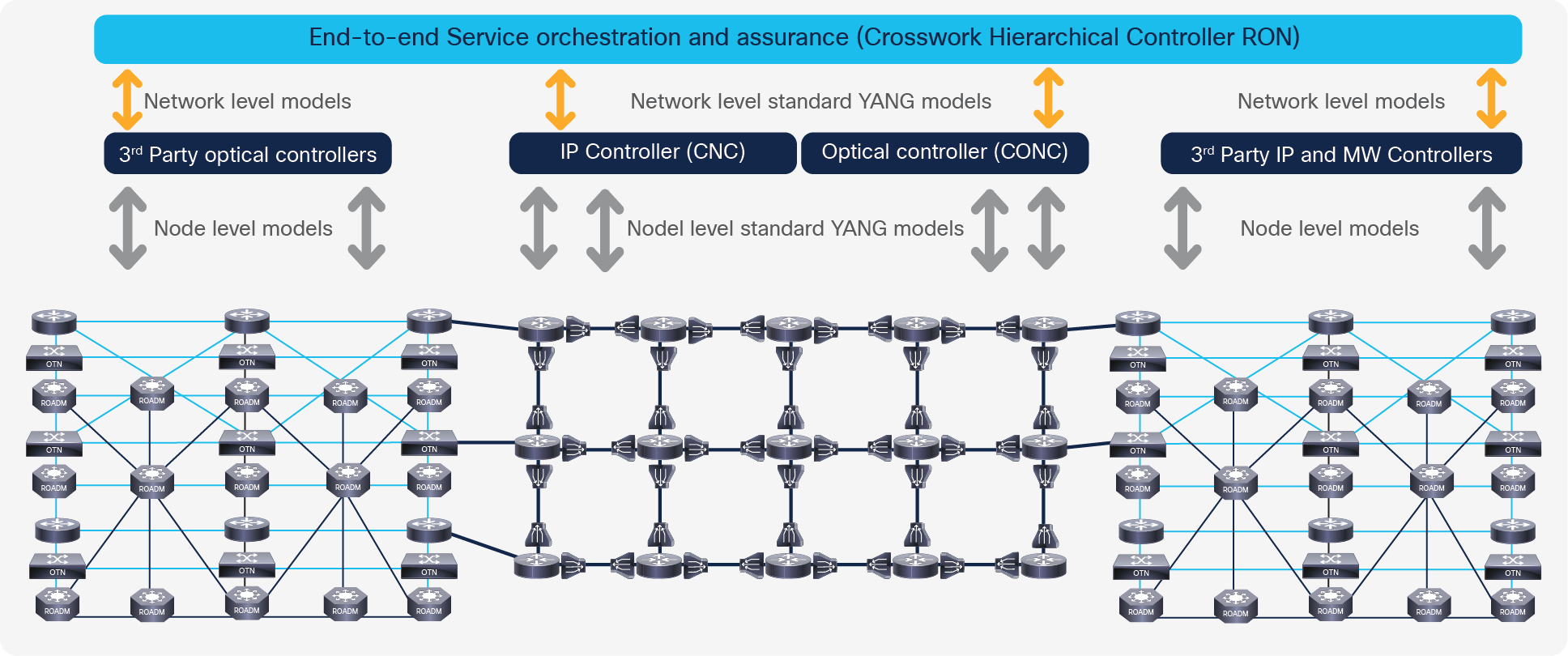
Role of Cisco Crosswork Hierarchical Controller in the routed optical network control architecture
The operation of the Cisco IP + optical domain is performed through a single pane of glass provided by the Crosswork Hierarchical Controller. The Crosswork Hierarchical Controller provides a real-time replica of the entire network (aka “digital twin”) to predictively understand any changes to the deployment, connectivity, and operations status of all network resources. This real-time view is leveraged to achieve optical path selection for new services as well as optimization of existing services.
Beyond the standard functionality expected from a hierarchical controller, Cisco Crosswork Hierarchical Controller goes the extra mile by simplifying the operation of integrated IP and optical networks. This is accomplished by simplifying the task of troubleshooting analog Dense Wavelength Division Multiplexing (DWDM) systems with the help of historical data and Multi-Layer based analysis of the data. It also provides easy-to-use assurance tools for services that reside on the network and allows customers to ask complex questions about network and service state via a simple query language. They can then use those results to build their own layer of reporting, analysis, and assurance tools around the solution.
A key distinctive attribute of the Cisco solution is the ability to tailor it to specific service provider needs. This can be done by implementing customer-specific service configuration models inside Crosswork Network Controller and Cisco Optical Network Controller, thanks to the use of Cisco Network Services Orchestrator (NSO) as the provisioning engine in these controllers. As the industry-leading service configuration tool, NSO brings the experience and richness of capabilities that do not typically exist in other relatively new SDN controllers.
Last but not least, the simplicity of managing the routed optical network domain in a unified and consistent manner can be extended to the other domains by connecting the hierarchical controller to their respective domain controllers.
The Crosswork Network Controller is the multivendor IP domain controller in the architecture. It allows customers to deploy IP services faster and enables intent-based network optimization mitigating network congestion issues. Cisco Crosswork Network Controller has been shaped by the experience of helping multiple tier-one service provider and large enterprise customers automate everything from simple IP device turn-up to sophisticated full lifecycle service management. The Cisco Network Controller combines intent-based network automation to deliver critical capabilities for IP service orchestration and fulfilment, network optimization, service path computation, device deployment and management, and fault remediation. The Cisco Crosswork Network Controller realizes a number of outcomes:
● Visualizing IP network and services inventory.
● Segment routing (SR) policy provisioning with explicit intent (for example, bandwidth constraints, latency minimization, etc.), simplifying 5G network slicing.
● IP services provisioning (for example, L2VPN, L3VPN services with associated segment routing policy).
● End-to-end IP service monitoring and health analysis.
● Collecting real-time performance information and optimizing the IP network to maintain the intent of the associated segment routing policy. Tactically optimizing the IP network during times of congestion with bandwidth optimization service.
● Migration from legacy to new IP networks (for example, device migration to replace older network devices with newer ones, migration from RSVP-TE to SR-TE, etc.).
● Ability to build customer-specific IP services and applications leveraging the Crosswork Network Controller APIs and telemetry data collected.
● Streamlining and automation of IP network-focused Method of Procedure (MOP) for remediation and maintenance tasks.
The Cisco Optical Network Controller (CONC) is the optical SDN domain controller for Cisco optical networks. CONC collects optical data that is used to provide network information in an abstracted format to the higher layer hierarchical controller. This abstraction enables centralized control of a Cisco optical network.
Some of the features of Cisco ONC are:
● Serves as a domain controller for optical products and provides data to hierarchical controllers. ONC supports a standardized TAPI model that enables it to abstract the device-level details from the hierarchical controller.
● As a provisioning network controller, monitors the topology (physical or virtual) of the network and collects information about the topology and setup/teardown of optical circuits.
● PCE service provides optical path computation.
IP and optical element management
Crosswork Automation provides unified IP and optical element management through the Evolved Programmable Network Manager (EPNM). EPNM provides the following functions within a Routed Optical Networking architecture:
● Device lifecycle management: Deep inventory discovery and visualization providing full device visibility along with interactive chassis view. End-of-life reports for network audits.
● Software image and configuration archive file management: Management of the configurations, including backup of the configurations in a centralized database, software download, and activation. Configuration compliance based on a golden network configuration for network audits and remediation.
● Monitoring performance and fault: Performance metrics collection and correlation and fault event processing. KPI monitoring and device-level alarm management with a single dashboard.
● Troubleshooting: Device-level troubleshooting tools including OTRD, Y.1731, Y.1564, IP SLA for connectivity verification.
A key to managing converged IP and optical networks is having a unified IP and optical planning tool. This solution for Routed Optical Networking is powered by the Cisco WAN Automation Engine (WAE). WAE provides the tools for capacity planning, failure analysis, and traffic engineering, as well as analyzing network health and traffic trends.
Cisco WAE is an integrated system for designing, engineering, and planning. It enables IT teams to explore the impact of failures and design changes on traffic flows, network performance, and reliability.
Cisco WAE through network planning and design tools enables service providers to improve traffic distribution, identify vulnerabilities, and mitigate risk. Used worldwide by network planners and engineers, WAE’s streamlined workflow and highly interactive interface enables providers to accurately model the network and quickly accomplish planning tasks to improve network efficiency and operational costs (OpEx) under different network stress conditions.
Attempting to meet the bandwidth and performance demands of your customers with constant capacity upgrades will erode your margins and significantly increase the complexity of your transport network.
Using a Converged SDN Transport architecture can improve your control of the network through software tools and simplification of network layers and protocols. Better overall control can result in simplification of management and operations, which will lead to savings and a reduction in TCO.
Building a routed optical network as part of a Converged SDN Transport framework can help you meet these challenges with a simplified network architecture and operations process. Using network automation tools will improve the utilization, resiliency, and flexibility of your network while helping to control costs.
Cisco’s Converged SDN Transport architecture combined with Crosswork Automation can turn your complex multilayer and multivendor infrastructure into a unified, easily controlled network. Cisco Crosswork offers a network automation platform to accelerate network planning and designs, simplify implementation, and proactively operate and optimize the network.
Experience game-changing innovation with a converged architecture and automation
If your network needs to deliver high-bandwidth services with uncompromising diversity and latency SLAs and dramatically lower costs, you’ll be interested in Cisco’s Converged SDN Transport and Routed Optical Networking solution with Crosswork Hierarchical Controller.
For more information on Cisco’s network automation portfolio for service providers, please visit www.cisco.com/go/crosswork. To learn more about Crosswork Hierarchical Controller or to schedule a demonstration, contact your Cisco sales representative.
For more information on how Converged SDN Transport is changing the economics of the network for service providers to deliver connected experiences at massive scale, please visit www.cisco.com/c/en/us/solutions/service-provider/converged-sdn-transport.html.
For more information on how service providers can evolve to Routed Optical Networking, please visit www.cisco.com/go/RON.